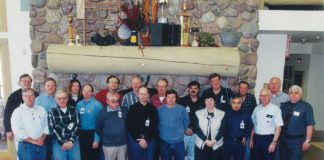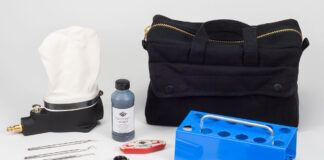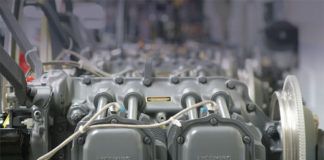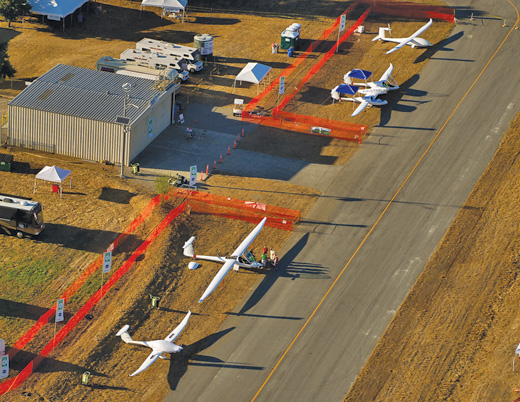
The flight line with Phoenix, Eco-Eagle, G4 and e-Genius ready to take on the Green Flight Challenge.
Northern California was the scene of the Green Flight Challenge sponsored by Google, held during the last week of September. With $1.65 million in prize money from NASA and competition management from the CAFE Foundation, the event became a huge media draw and strong evidence that new technologies could become the future of general aviation.
Originally scheduled for July 2011, NASA and the CAFE Foundation had postponed the GFC in part because several teams were not ready to participate. However, even with the extension, only four teams fielded entries, a big drop from the 13 registered at the end of 2010. This was very different from the ratio of teams showing up versus teams registered for similar events. The Berblinger Prize, held in concert with Aero Expo at Friedrichshafen, Germany, in April, had 36 groups ready to send aircraft. Of those, only 24 teams came, 13 began the actual competition flight, and eight finished the course.
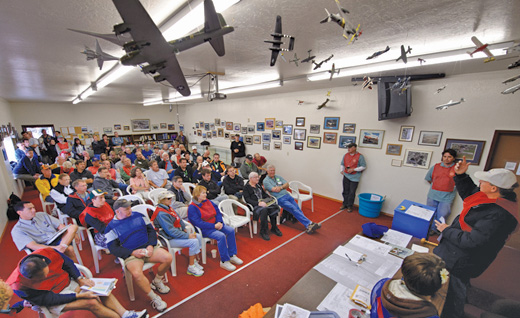
Brien Seeley leads the first morning’s briefing at the GFC.
Day One
On Sunday, Stuttgart University’s Team e-Genius, captained by Eric Raymond, rolled into the staging and impound area for the competition at Charles M. Schulz Sonoma County Airport, in Santa Rosa, California. Its tail-mounted prop and high-wing motorglider appearance promised good performance on low power. Rudolf Voit-Nitschmann, Stuttgart professor and advisor to the team, said the design was based on the school’s 1996 Icare II, a solar-powered airplane that flew at Oshkosh in 1997 and in which glider pilot Klaus Ohlmann had set two world solar distance records only months before the Challenge. It was a rebuild of the school’s Hydrogenius, cancelled because the promised delivery of fuel cells did not come through.
Team Pipistrel-USA’s G4, an imposing sight with two fuselages, a wide, thick center section (necessary to ensure the required 52-knot landing speed) and large, elegant wood propeller extending from the centerline motor housing followed, crewed by a large team led by Jack Langelaan of Penn State. Ivo Boscarol, founder and CEO of the Slovenian company, said the design, construction and test flights spanned only five months.
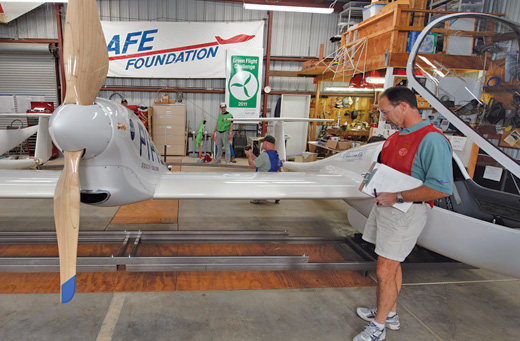
Weight Chief Wayne Cook leans against the G4 while observing the elaborate metal frame that the Pipistrel team brought along to allow the CAFE scales to be used with the uniquely configured airplane. Note the exotic propeller.
Jim Lee, Team Phoenix Air USA leader, copilot Jeff Shingleton and emergency backup pilot Timothy Ettridge made up the smallest team and flew the smallest airplane, a stock Phoenix motorglider.
Finally, with the 2:30 p.m. deadline for technical inspections looming, Embry-Riddle Aeronautical University’s team, led by graduate student Lisa Costello, brought in its Eco-Eagle, a modified Stemme S-10 motorglider.
The Embry-Riddle team brought with it two problems: a single pilot and a ballistic parachute that had not been installed in time. The CAFE rules require two pilots in a two-seat airplane, but university rules forbid a second student in an Experimental aircraft. After their heroic drive from Florida, it would have been a disaster to many of their thesis projects had Eco-Eagle not been allowed to fly. Jack Langelaan proposed allowing the team to participate on a demonstration-only basis, with Mikhael Ponso at the helm, and not compete. This way the Eco-Eagle’s performance could be monitored along with the competition aircraft, and the team would have solid numbers to take home as evidence of their hard work.
Only the Phoenix had been weighed as of that Sunday evening, so Langelaan’s proposal during the pilot briefing Monday morning allowed the Challenge to move forward. Remaining aircraft were weighed under the watchful eye of Wayne Cook and Otis Holt, CAFE volunteers.
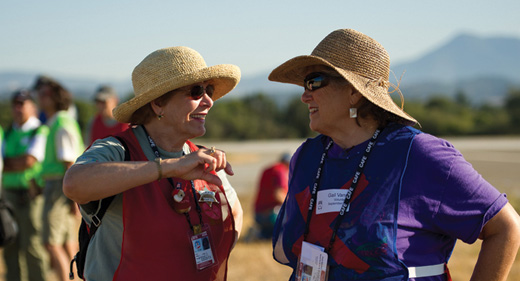
CAFE volunteers Meg Hurt and Gail Vann discuss the day’s events.
Objections were raised to weighing aircraft both before and after each flight, so the weighing team weighed only fuel and pilots pre- and post-flight, streamlining what otherwise might have been a laborious and time-consuming process. Jeff Shingleton of the Phoenix team noted that the Plexiglas-bubble-enclosed cockpits on the aircraft easily created a sauna-like atmosphere in the heat of the 90°-plus days, steaming 2 pounds from the pilots on their 2-hour flights. To exacerbate matters, all teams flew with vents closed to attain maximum performance.
With weighing completed, teams rolled into position for the first test, a combined noise and climbout challenge. Airplanes could not exceed 78 dBA at a measuring point 250 feet from the 2000-foot mark on Runway 19 as the aircraft flew over at full power. At that same point, the airplanes had to be at least 50 feet in the air, clearing an imaginary barrier represented by a flag atop a cherry picker.
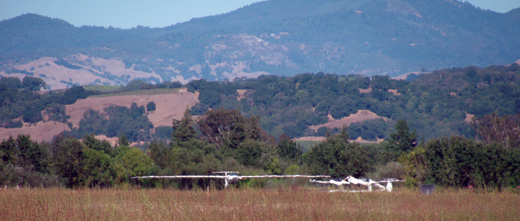
The Embry-Riddle Stemme and Pipistrel G4 form a Felliniesque vision in heat waves.
Mise en Scène
Resembling a Fellini set, the airport’s dry brush seared by the high sun and topped by the azure cloud-streaked sky formed an almost surreal backdrop for the elegant white shapes passing overhead. As e-Genius was making its pass, a Cessna was cleared to take off on an adjoining runway. Pilots Eric Raymond and Klaus Ohlmann requested a do-over. Although observers would not learn this until the CAFE banquet, their first run, even with background help, registered a mere 62 dBA—roughly equivalent to a vacuum cleaner. Their second attempt hit a sub-conversation-level 56 dBA. All craft were well below the 78 dBA allowed.
Tuesday followed a night’s recharging (tended to by CAFE volunteer Alan Soule) for e-Genius, the G4 and the battery pack for the Eco-Eagle. Fuel was weighed for the Embry-Riddle team and the Phoenix, all pilots were weighed, and all was readied for the first of two 200-mile flights.
Eco-Eagle’s unique hybrid used a Rotax engine only for takeoff and a clutched electric motor only for cruise, drawing from the wing-mounted batteries.
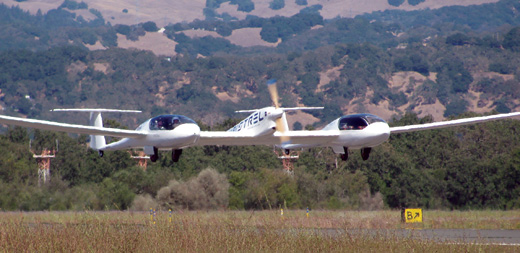
Batman (Dave Morss) and Robin (Robin Reid) ascend into an afternoon heat wave. The airplanes climbed well despite the 90° days.
Takeoff and Return
Golf carts towed the contenders to a hold-short position on the taxiway, which was perpendicular to the impound area to avoid fuel or electron use until the airplane fired up and taxied onto Runway 19. There they paused for the takeoff countdown and for Mike Fenn, CAFE hangar boss and safety chief, to drop the green flag. As each airplane departed, it headed northwest, reached the required 4000-foot cruise altitude within 17 miles of takeoff, and began four circuits of the course, which took it over turnpoints near the geothermal generating stations near Geyserville.
Each return of a high, white shape brought a flurry of excitement to the crowd and speculation about how closely each was maintaining the necessary 100-mph average. In the cockpits, pilots tracked a course line within one mile and on the outside of each turn point stayed within a half-mile radius.
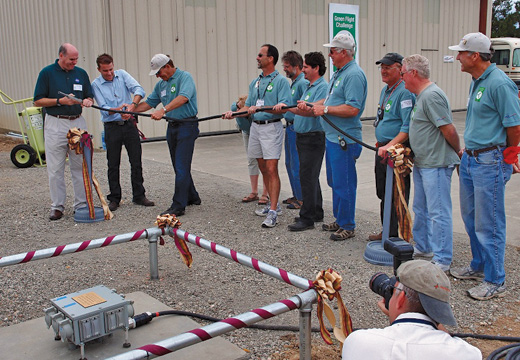
NASA’s Joe Parrish holds a symbolic fuel nozzle while Sonoma County Supervisor Mike McGuire cuts the hose to open CAFE’s electric aircraft charging station. The CAFE board looks on.
After two hours, e-Genius and the G4 landed, followed by Eco-Eagle, and after another long interval, Phoenix. Phoenix had taken advantage of a rule allowing a 70-mph speed for fuel-powered aircraft. Jim Lee had climbed to a maximum-allowed 6500 feet, switched off the Rotax, and used best gliding speed to cruise back to 4000 feet, where he restarted the engine. Employing this sawtooth approach, the Phoenix team hoped to pair the best fuel mileage with a reasonable course speed. Slower than the others on the course, Lee made a swift descent at the end of his run and wowed everyone with a steep climbing turn around the CAFE hangar.
Pilots shut down their powerplants, and four team members overseen by CAFE security pushed the aircraft back to the impound area, while yet another team weighed fuel and pilots. Volunteers from EAA Chapter 124 watched over the airplanes at night.
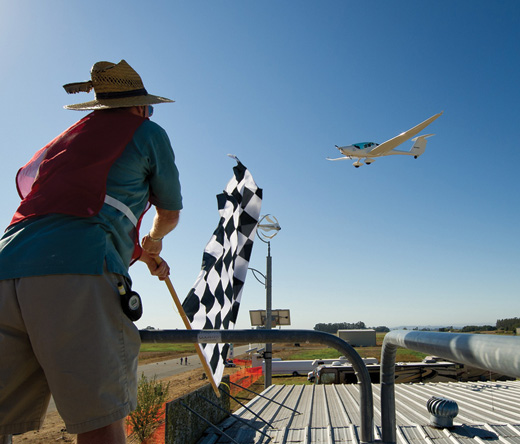
Mike Fenn waves Phoenix across the finish line.
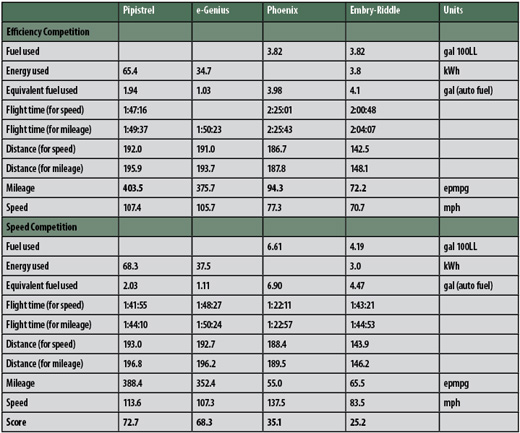
CAFE downloaded data from the netbooks carried on each aircraft, capturing flight information such as heading, speed, altitude and energy use. These numbers were then analyzed by an e-totalizer, which helped determine the scores for all of the entrants.
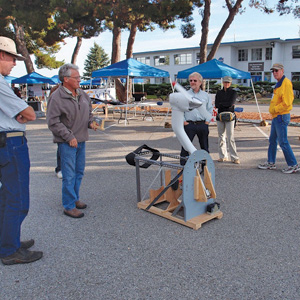
Patrick McLaughlin demonstrates an A.I.R. motor controller with a Joby motor in a Windward Performance Duckhawk mounting.
Wednesday was a down day, originally scheduled as an alternate flight day. Thursday dawned bright and sunny, with temperatures in the high 80s and low 90s, another sauna experience for the pilots. The challenge of the day was a high-speed run, tweaking a bit more mph at the expense of a few mpg. The contenders were already pushing their respective performance envelopes, so there was little surprise that the speed run was not that much speedier than the economy run, except for Phoenix. Lee took a more straightforward approach to the course and returned from his four laps much earlier than the others, performing a neat dive followed by a chandelle-like maneuver that put him in the landing pattern. Again, results were kept in confidence until the following Monday’s awards ceremony.
On Friday, teams unwound from the tension of the previous five days by staging a golf-cart race, festooning their mounts with purple surgical gloves, flux capacitors and deceleration ‘chutes. All eight drivers, in a random relay, took turns flinging the electric carts through a sort of slalom, reversing and parking course. There were at least eight GoPro cameras on one cart, and the edited footage is dizzying. Saturday saw an open house for the public to view the GFC aircraft, a ceremonial opening of the first electric aircraft charging station in the country and a celebratory banquet that evening. Sunday allowed movement of teams and aircraft to Moffett Field.

John McGinnis shows off the quarter-scale Synergy to Eric Lindbergh, NASA’s Mark Moore and LEAP CEO Yolanka Wulff.
Google GFC Expo and Prizes
The Google Green Flight Challenge Exposition was hosted by NASA and had more than 20 exhibitors at NASA Ames Research Center, Moffett Field. Spectators got to see the GFC competitors and many green transportation exhibits.
The GFC prize ceremony, with a surprise anti-climax, was held in Building 3, crowded with reporters and camera crews for the local affiliates of ABC, CBS and NBC, and NASA.
Brien Seeley, head of CAFE, said he saw this as a “pivotal historic event,” with future aerial vehicles quiet, emissions-free and capable of landing anywhere—in other words, achieving bird-like flight.
Erik Lindbergh of the Lindbergh Electric Aircraft Prize (LEAP) awarded $10,000 donated by Jeannie Schulz, widow of Peanuts creator Charles Schulz, to team leader Eric Raymond and e-Genius for the quietest aircraft for its average of 59 dBA on two takeoffs.
NASA’s acting Chief Technical Officer, Joe Parrish, named other prizes that created a similar level of creative achievement, including the Orteig Prize (Charles Lindbergh and the Spirit of St. Louis) and Ansari X Prize (Burt Rutan and SpaceShipOne), and predicted that the GFC will inspire a renaissance in aircraft technology. NASA and the U.S. taxpayer benefit from funding such prizes, whereas NASA “only pays if it works,” he said. The comment drew a good laugh and a round of applause from the throng.

Greg Stevenson’s GSE/Aerochia partial mockup (not completed in time for the GFC) was displayed in front of the historic Moffett Field airship hangar.
NASA’s $1.65 million prize money generated $4 million in expenditures by competitors and produced better-than-expected results. Second place winner e-Genius was not only the quietest competitor, but it also took $120,000 in prize money for its 375.8 passenger mpg (epmpg). Pipistrel’s winning entry attained 403.5 epmpg and captured the $1.35 million prize, along with a bird-themed trophy by local sculptor Ralph Carlson. It was designed by CAFE president Seeley, his wife, Anne, son Damon and CAFE board member Bruno Mombrinie.
Ivo Boscarol pledged $100,000 of his team’s prize money to a challenge that would loft the first supersonic electric airplane.
The anti-climactic part was that Embry-Riddle and Phoenix Aircraft had to await the results of their documented performance.
The day ended just ahead of an encroaching rainstorm, with a flyby from the GFC aircraft. It was a revelation to some, and a promise of even grander things to come.
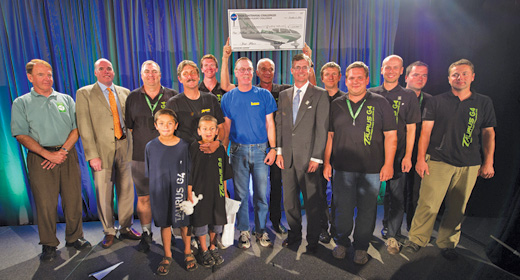
The Pipistrel G4 team with Jack Langelaan in a suit, pilot Dave Morss in blue Batman T-shirt, copilot Robin Reid in black Robin T-shirt, and Ivo Boscarol holding a check. Design Chief Tine Tomazic is to the right of Morss, and CAFE head Brien Seeley and NASA Technology Chief Joe Parrish are on the left in the back row.
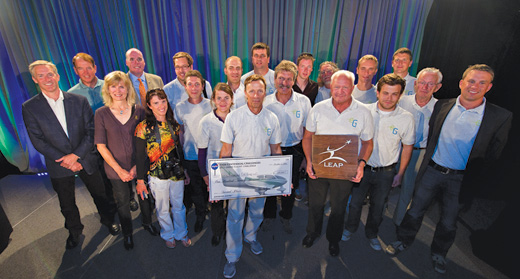
The e-Genius team: Eric Raymond holds a check, Rudolf Voit-Nitschmann holds the LEAP quiet aircraft plaque, and Klaus Ohlmann is between them.
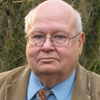
![]()
Dean Sigler has been a technical writer for 30 years, with a liberal arts background and a Master’s degree in education. He writes the CAFE Foundation blog and has spoken at the last two Electric Aircraft Symposia and at two Experimental Soaring Association workshops. Part of the Perlan Project, he is a private pilot, and hopes to get a sailplane rating soon.


